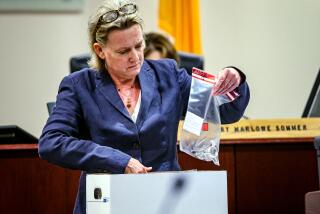Judge in Simpson Civil Trial Blocks Defense Queries
- Share via
A judge blocked several questions from O.J. Simpson’s lawyers Monday, frustrating their attempts to show that evidence was contaminated as well as planted--theories that worked to acquit Simpson in his murder trial.
Feeling unfairly stymied by Superior Court Judge Hiroshi Fujisaki’s rulings, Simpson attorney Robert Baker filed a writ Friday asking the 2nd District Court of Appeal to stop the trial and rule on what can be asked during cross-examination.
The appeal was still pending late Monday, a clerk for the appeals court said. Plaintiffs have until Tuesday to respond.
Fujisaki has cut short cross-examinations of the last several witnesses, ruling what wasn’t brought up during direct examination couldn’t be questioned during cross-examination.
The judge has told the defense that it can call witnesses back during their portion of the wrongful death trial.
Former police lab supervisor Gregory Matheson, who spent five days guiding jurors through the workings of DNA and other blood testing procedures at Simpson’s murder trial, barely mentioned the subject in less than four hours of testimony.
Criminalist Dennis Fung, who spent nine days on the stand in the first trial, followed Matheson, identifying bloodstains he collected.
Matheson explained conventional analysis of blood and said preliminary tests using that method showed that Simpson was one of 550 to 570 people in the population who could have left a blood drop on the front walk at the murder scene.
But Matheson glossed over the socks found at the foot of Simpson’s bed the day after Nicole Brown Simpson and Ronald L. Goldman were slashed to death outside her condominium.
Plaintiff attorney Tom Lambert was clearly aiming for damage control in his brief questioning of Matheson.
Matheson, who is now chief forensic chemist for the Los Angeles Police Department, acknowledged that he did not see blood on the socks when they were collected June 13, 1994. He examined them again June 29 and still did not notice any blood.
It was left to defense attorney Robert Blasier to tell jurors that criminalist Collin Yamauchi studied the socks in his laboratory on Aug. 4 and found copious amounts of blood.
“On Aug. 4, is it correct that’s the first time Mr. Yamauchi looked and determined blood was visible to the naked eye?” Blasier asked.
“That was the first day blood was located, yes,” Matheson said.
Matheson emphasized that the socks were so dark he wouldn’t have seen bloodstains because blood also is very dark when it dries.
Simpson is accused of causing the deaths of Nicole Brown Simpson and Goldman. If he is held liable, jurors could recommend monetary damages.
More to Read
Sign up for Essential California
The most important California stories and recommendations in your inbox every morning.
You may occasionally receive promotional content from the Los Angeles Times.










